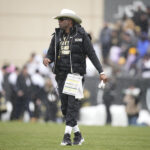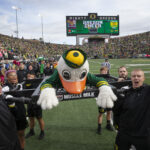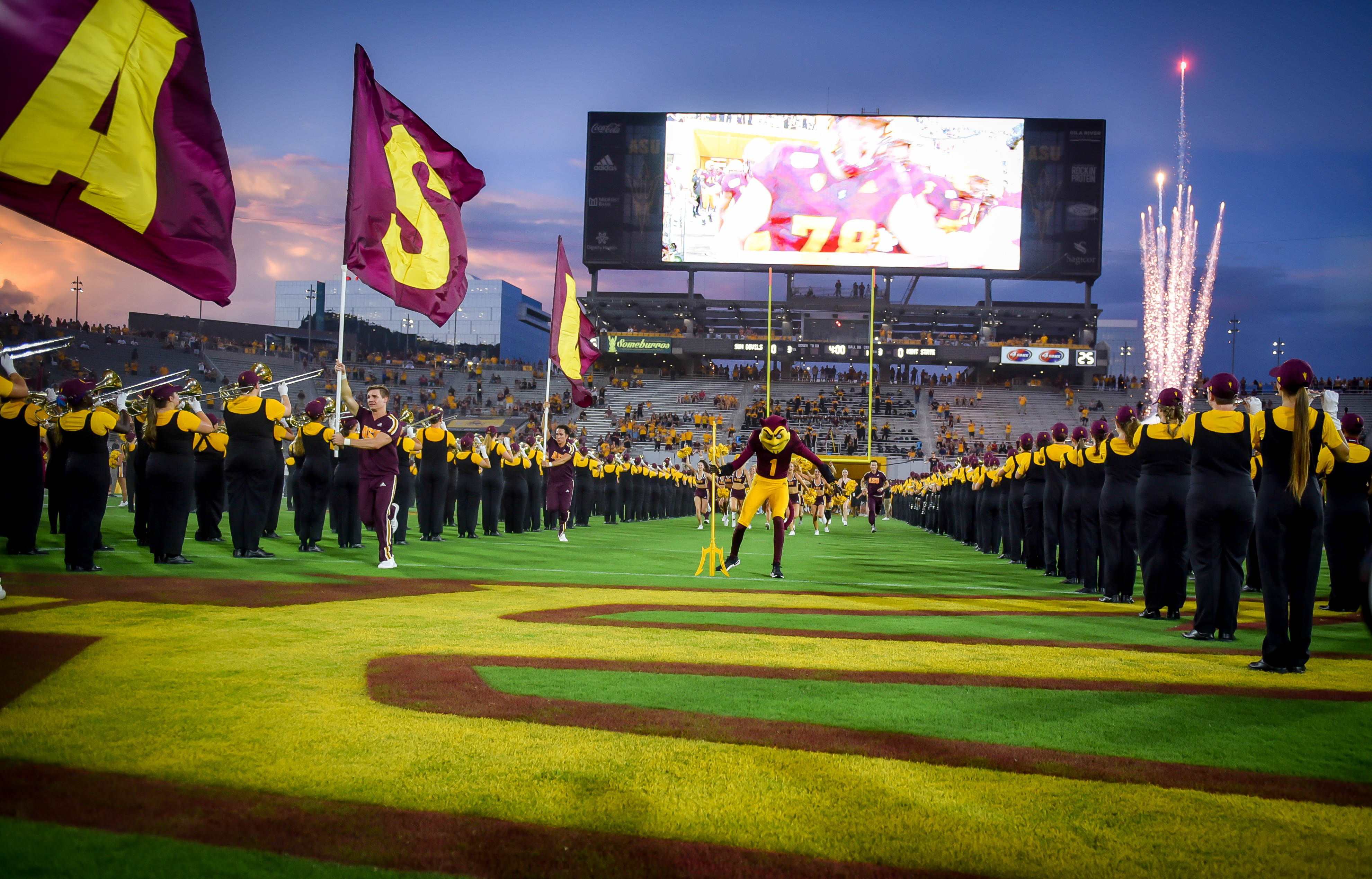Reaction to developments on the field, and off …
1. ASU’s growing mess
Arizona State dominated the news late this week, and not in a manner likely to generate ‘forks up’ signs from the Sun Devil faithful.
Remember the three assistant coaches who were placed on administrative leave during the summer, following allegations of recruiting transgressions during the pandemic? They’re gone. Two have been fired and one resigned.
But the real stunner was offensive coordinator Zak Hill’s resignation. Less than a week before National Signing Day, ASU’s play-caller signed off.
The Athletic called Hill’s departure “the latest blow for coach Herm Edwards’ Arizona State program, a situation that could get worse before the start of the 2022 season.”
It could get much, much worse as the NCAA’s investigation into a litany of potential violations churns forward.
Among the barrage of developments Friday was this insight from SunDevilSource:
“Athletic department officials have privately expressed concern to colleagues and others about the serious nature and far-reaching implications of the case ASU is facing, which is expected to include Level I violations.”
Level I violations are the most serious in the NCAA penalty matrix; they qualify as major infractions. The Arizona basketball was hit with multiple Level I violations in the case involving former coach Sean Miller and the FBI.
Arizona State is no stranger to major violations, either.
In fact, the Sun Devils are one case away from a place of prominence in the NCAA’s Pantheon of Infractions Ignominy.
Southern Methodist has been guilty of 10 major infractions cases over the history of its athletic department (across all sports), according to the NCAA database.
Arizona State is tied for second place with Texas A&M — each school has nine major infractions cases to its name.
If the current investigation determines major violations occurred, and all indications point to that, the Sun Devils would pull even with SMU for the highest number in NCAA history.
Talk about company you don’t want to keep.
2. In the NCAA wheelhouse
One reason Level I violations appear inevitable for the Sun Devils: They’re an easy target for the NCAA.
Here’s an association with little credibility, an uncertain future, and a ghastly recent track record on infractions cases. That’s particularly true of incidents that fall outside its standard enforcement purview, like academic fraud (North Carolina) and sexual assault (Baylor).
But the allegations against the Sun Devils are built on improprieties in the recruiting space — that’s wheelhouse stuff for the NCAA. Hosting prospects during a dead period prompted by a global pandemic is an ethical and moral breach far more egregious than cheating in normal times. If the NCAA blasts ASU, nobody will move an inch to defend the school or the process. Politically, it’s a winner for an association used to losing.
The case is made easier by the availability of evidence. Not only was a dossier of documents delivered to Indianapolis, but the primary sources of additional information are recruits who either signed with ASU or other schools. The NCAA doesn’t have subpoena power, but it does control eligibility: If the players don’t play along with investigators, they might not play at all.
The Sun Devils are fresh meat in this regard: Their status as a Power Five school but not blue blood. Debilitating sanctions would have a limited impact on the college football writ large — and limited impact within the Pac-12, as well.
ASU is big enough to serve as an example that the NCAA enforcement process still has teeth but not so big that exacting a hunk of flesh would affect the sport’s machinery.
3. The recovery phase
ASU has parted ways with four of the assistants who allegedly participated “in impermissible local meetings with recruits,” according to SunDevilSource. But NCAA investigators were reportedly told in interviews that head coach Herm Edwards and defensive coordinator Antonio Pierce also participated.
They have not been fired, yet.
It’s difficult to imagine Pierce on the staff next season. He was the alleged mastermind of ASU’s recruiting plan, although we question the intelligence of a plan so brazen, so blatant and so deplorable that it could wallop the football program for years to come.
Look for him to join an NFL staff and leave behind a path of destruction.
Will Edwards remain in charge? If it’s true that he participated in, or knew about the recruiting visits during the dead period, he should be fired — of course, he should be fired.
But because Edwards is close friends and former business partners with athletic director Ray Anderson, anything is possible. Anderson already told the players (after the regular-season finale against Arizona) that Edwards would return for ’22.
We don’t believe it’s quite that simple.
If the NCAA’s Notice of Allegations is delivered to ASU before the season, and if Edwards is implicated, the optics would force the Sun Devils to make a move.
(Also, why would Edwards want to continue coaching under those circumstances? The glare and criticism would be intense.)
Bottom line: The deeper ASU digs in, the longer ASU resists, the greater the damage and more prolonged the recovery.
Every move should be geared toward positioning the program for its next chapter after the NCAA has delivered the sanctions and the clouds of scandal fade.
4. Division dynamics
Step back from the latest developments, and the canvass comes into focus: ASU seemingly missed its opportunity in the South.
Think back to the state of play across the division when Edwards was hired in the late fall of 2017.
USC had just won the conference title, but Sam Darnold was moving on and nobody feared the Clay Helton regime. UCLA and Arizona were changing coaches. Colorado had regressed after its 2016 uptick, and Utah lost twice as many conference games as it won.
There was opportunity galore.
Now here we are, four seasons and one pandemic later, and the Sun Devils have nothing to show for their self-proclaimed New Leadership Model.
Edwards hasn’t won the division and has yet to appear in the end-of-season AP rankings. Instead, Utah filled the void, winning the South in ’18, ’19, and ’21 — not with a new model but with the same old coach.
And looking forward, the window appears to be closing fast on ASU.
Between Utah’s loaded returning roster and USC’s awakening under Lincoln Riley, it’s difficult to see a path to the South title for the Sun Devils — either next season or in future seasons.
We wouldn’t be surprised to see them looking up at Arizona within two years.
5. Big dollars, no sense
To one degree or another, every public university in the Pac-12 subsidizes its athletic department. Money is routed from central campus to athletics through student fees, direct institutional support, or indirect means.
The level of financial support varies by the campus and the business model. (Even sister schools can take wildly disparate approaches.)
In the 2020 fiscal year — the last for which all the budgets have been made public — Arizona State directed $29.4 million from central campus to its athletic department, according to data published by USA Today.
That was the second-highest subsidy in the conference behind Cal ($30.9 million), which has four more intercollegiate sports than ASU. Nobody else was even close, including Arizona ($14.4 million).
Put another way: Institutional support accounted for 27.4 percent of the Sun Devils’ total operating revenue ($107 million) in FY2020.
All that money plowed into athletics, and the program relied upon to lead the way — to help spread the ASU brand nationally, to serve as a shining light in the desert — is immersed in a scandal entirely of its own making.
A scandal that threatens to heap embarrassment on the university and overshadow everything that massive cash outlay is designed to support.
Perhaps ASU should have devoted a fraction of the $29.4 million toward making sure its football coaches were following the rules.
Support the Hotline: Receive three months of unlimited access for just 99 cents. Yep, that’s 99 cents for 90 days, with the option to cancel anytime. Details are here, and thanks for your support.
*** Send suggestions, comments and tips (confidentiality guaranteed) to pac12hotline@bayareanewsgroup.com or call 408-920-5716
*** Follow me on Twitter: @WilnerHotline
*** Pac-12 Hotline is not endorsed or sponsored by the Pac-12 Conference, and the views expressed herein do not necessarily reflect the views of the Conference.
Related posts:
 Seeking integrity: How the Pac-12 moved to protect itself from a gambling scandal
Seeking integrity: How the Pac-12 moved to protect itself from a gambling scandal
 Pac-12 media rights: The home stretch arrives (or maybe not) as changes come to the power structure
Pac-12 media rights: The home stretch arrives (or maybe not) as changes come to the power structure

(AP Photo/David Zalubowski)
Pac-12 survival: All eyes on Colorado as university regents meet to discuss Big 12 move
(AP Photo/Chris Pietsch)
Mailbag: Next steps for Oregon and UW, the Bay Area void, Arizona’s role, the $40 million question, expansion options and moreJon Wilner
Jon Wilner has been covering college sports for decades and is an AP top-25 football and basketball voter as well as a Heisman Trophy voter. He was named Beat Writer of the Year in 2013 by the Football Writers Association of America for his coverage of the Pac-12, won first place for feature writing in 2016 in the Associated Press Sports Editors writing contest and is a five-time APSE honoree.
